iOS App Development: Ultimate Adviser
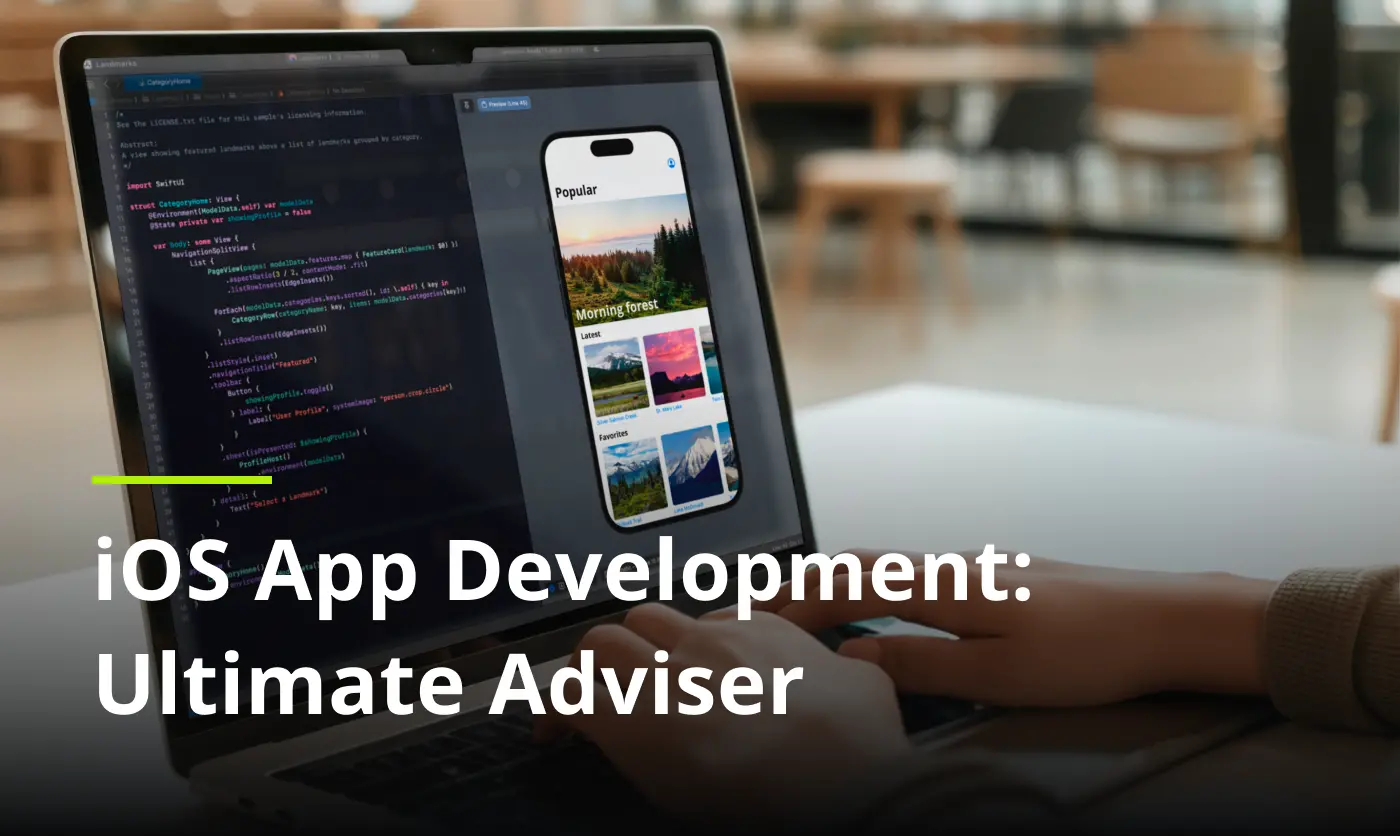
Bitting the bullet with iOS app development is not a joke, so diving deeper into this topic may feel like tackling the challenge directly — you are overwhelmed with a lot of data. To build a solution that fits like a glove to custom needs, you have to ensure you know the nitty-gritty behind the topic of app creation in the United Kingdom, and we are here to get you covered.
Choosing the right partner from the very beginning will significantly impact your app’s success. If you’re looking for an experienced mobile app development services in the UK that delivers tailor-made iOS solutions, Limeup offers end-to-end support — from idea validation to App Store launch.
iPhone app development is your golden ticket to a wide range of target audiences since the market share is 27.1%, and you would definitely like to represent your application within AppStore. The tricky moment is about the developing process where you have to jump through hoops, and without a detailed guide, it’s a daunting task such as choosing app development companies in the UK.
Here, we have compiled guidance on iOS mobile application development covering everything from tech stack to beneficial moments, trends, and challenges to overcome. Let’s jump right into the article to learn how to create such a solution.
What is an iOS app development?
Being an exciting skill for developers seeking an opportunity to tap into the lucrative Apple platform, such creation has become in demand, according to a billion online ecosystem users who are looking for innovative apps that cater to their ever-evolving needs.
Crowded AppStore is filled with games, social media, and other apps, and you have to know the requirements for representing users with a blue-thinking solution. There are 3.8 billion smartphone users worldwide who have, on average, 18 apps installed across the US, you would definitely like to take this niche.
iOS apps development has broader considerations that aspiring engineers have to follow before diving into the creation process, requiring knowledge from design philosophy to user base expectations and overall ecosystem you have to stay stick to. Apple users are also known for their affinity to receiving intuitive interfaces, 24/7 support, seamless user experiences.
Beyond compliance, you have to take into account scalability, feature updates, ongoing support to ensure that an app remains relevant to rules and users’ expectations. Further, we will consider core concepts, tools, resources to be used when you decide to develop such a solution. With fundamentals in mind, let’s dive deeper into the platform’s requirements:

- Mac laptop/iMac sounds obvious but here we go with a need for a related device since tools we will consider later are exclusive for MacOS, and you need software for app real-world testing on iPhone or iPad which is crucial for performance evaluation.
- Xcode in the environment for a development process that runs only on MacOS and is used for developing, testing, debugging, distributing app software. You are able to code and design an app faster and effortlessly, and according to the latest 16 version, there are predictive code completion and faster previews for your comfort.
- iOS SDK in app development for iOS more known as Software Development Kit provides essential tools, libraries and frameworks for the creation process — camera, sensors integrations, smooth animations, interface, compliance with the Apple ecosystem, you are able to reach out to a wide range of services.
- Requirements for AppStore are all about high standards of quality, security and user-friendliness/experience, such guidelines ensure security and privacy, app functionality and performance, enable development approval and distribution, boost trustworthiness.
- Hard skills in Swift and Objective-C are the only way to build an app for iOS, enabling you the opportunity to develop feature-rich and efficient solutions. Swift has a concise syntax that is simultaneously user-friendly, with safety features in mind and active support. Objective-C is integrable with C and C++ programming languages and they matter both.
If you’re unsure which language to prioritize when hiring or planning your development roadmap, here’s a quick breakdown of Swift vs Objective-C to help you make an informed decision based on performance, learning curve, and long-term project scalability.
| Feature | Swift | Objective-C |
| Release Year | 2014 | 1984 |
| Syntax | Clean, modern, concise | Verbose, traditional C-style |
| Ease of Learning | Easier for beginners | Steeper learning curve |
| Performance | Generally faster, especially for modern devices | Slower, more overhead due to dynamic nature |
| Safety | Strongly typed with modern safety features (e.g., optionals, error handling) | Prone to null pointer exceptions, less compile-time safety |
| Interoperability | Can work with Objective-C code | Native, integrates with C and C++ |
| Community & Support | Rapidly growing, actively maintained by Apple | Mature but slowly declining in usage |
| Use Case | Preferred for new iOS projects | Used in legacy codebases or when integrating with C libraries |
How to create an iOS app in 2026?
We will gladly let the cat out of the bag when it comes to app creation so you will learn profitable idea creation, implementation, testing and other crucial steps. We will go through the app publishing process, guidelines and much more for you to be encouraged about the first iPhone application development.
To put it simply, such an app operates on iOS-related devices and follows strict Apple rules and the process is a multifaceted combination of creativity and hard skills expertise with in-depth knowledge of the Apple ecosystem. Efficient code, clean architecture, engaging design — you have to consider all these points in the development process.
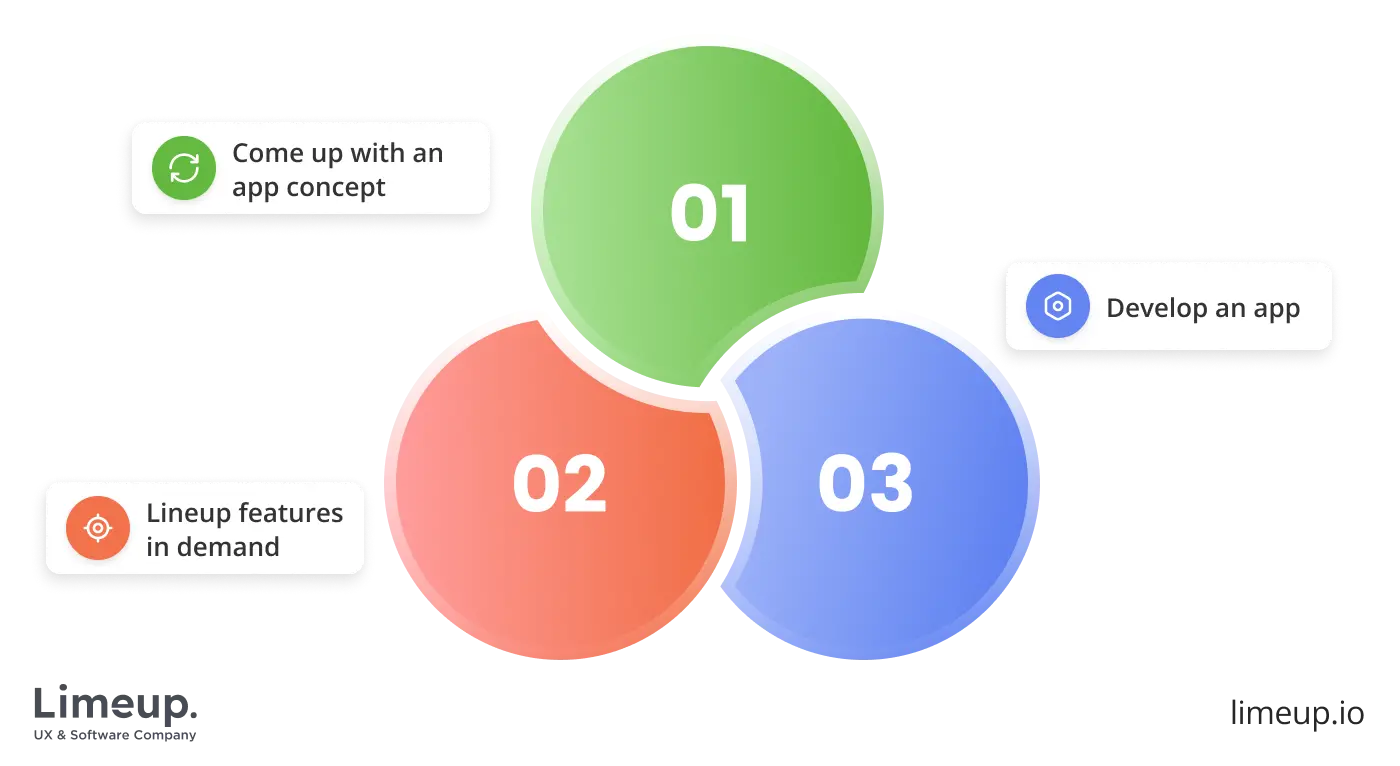
In this part of the article we will reveal essential steps and tools that shape such a creation journey:
— Come up with an app concept.
Working on the great idea is a complicated process where you need a handful of tools and a clear understanding of what needs to be built since with app purpose and business value, target audience understanding will be easier to represent in-demand app online. Your development process will be focused on specific needs meeting with no resources wasted and potential user dissatisfaction.
— Lineup features in demand.
A clear roadmap for you and stakeholders is all about pre-defining what features you will implement and core functionality so that you are able to prioritize tasks, develop iOS app with wisely allocated resources, avoid scope creep. It also impacts user experience since you are focusing on their requirements, it sets realistic timeframes, budgeting with no delays or cost overruns.
— Develop an app.
We have come to one of the most tricky moments and you would definitely like to know, “How exactly should I approach coding?”. Well, it depends on your skills and desires, we will come with detailed instructions. So, the first point here is for you to learn coding, spend a few years with Swift and Objective-C and build your own app.
Sounds tiring and like a long-term project with many variables, so we decided you would like to learn about another one — hire one of the app development companies in London that can provide you with consultation and offer a tailored number of services and take on every tech-related challenge you may face.
For example, talking about iOS app development in the UK, Limeup brings to the table 10+ years of experience in creating reliable solutions for businesses in fintech, healthcare, education, and real estate industries.
Technology stack for iPhone app development
You may think, “Well, I am about to hire a team of developers, why is such a blog post here?” trust us you would like to learn more about app creation and what to test in a potential vendor when it comes to cooperation.
Therefore, there are backend and frontend, hosting-related topics and we will consider more than just programming languages but development tools, frameworks and libraries for your comfort:
| Type | Technology | Description |
| Programming languages | Swift and Objective-C | Being a global and intuitive programming language, Swift is used to develop app for iPhone — open-sourced and easy to use. |
| Integrated development environment (IDE) | Xcode | It provides tools for development in Swift, offering the ability for multi-platform creation, a user-friendly interface, and built-in tools for effective work. |
| UI frameworks | UIKit and SwiftUI | The first one provides features for app infrastructure creation and more, the second one is a toolkit for app designing process. |
| Database | Core Data, SQLite, Firebase | In Apple development documentation, Core Data is all about saving data for offline usage, while SQLite is a library and Firebase is an app creation platform. |
| Testing | LamdbaTest, Appium | The first one is an AI-powered tool |
| Cloud services | AWS, Apple CloudKit, Firebase | They are used for backend infrastructure, file storage, payments, authentication and more. |
As for the iPhone apps development, the choosing process is a bit complicated so we recommend researching this topic or using our further steps and we will start with defining your Whys like what is the purpose of your application, your budget, platforms, processes to be automated, users’ expectations.
We also can give advice that stands for long-term, out-of-the-box thinking even if you have no other choice than Swift programming language but you can choose the developer’s level and expected user experience to be received. Still, in the table above we have considered frameworks and libraries for your choice for native development.
Another crucial point to consider is your project scope of work and size since MVPs are simpler, built with core functionality in mind, while enterprise-grade iOS apps require various cloud services and more. Scalability in developing iOS app in terms of increasing traffic loads requires a combination of programming languages and frameworks to handle more users.
Therefore, we recommend reaching out to a vendor that can consider security, complexity and other crucial points for you to simplify your market-entering journey. It will define a set of features, app goals, ideal options of tech stack and more to take care of your project and offer a headache-free development process.
Security in iOS application development
In terms of best practices and tools, we can answer your question, “What should I know as a business owner?” and let’s start with App Sandbox created by Apple as an isolated sandbox environment that is aimed at restricting access to the system, app data, enhancing security and more.
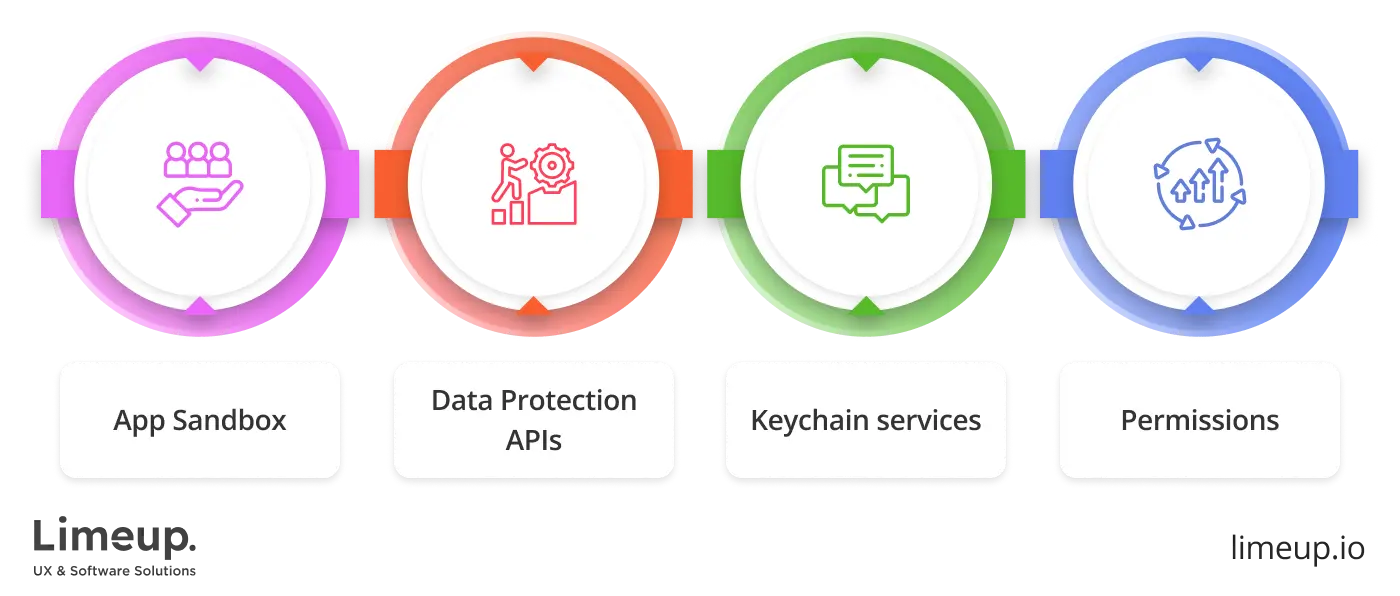
Data Protection APIs for encryption in files and keychains ensure that sensitive information may be accessed when the device is unlocked with Face ID, Touch ID or number-based code simultaneously with the implementation of keychain services for passwords, encryption keys and more.
Another crucial point to be considered is about permissions from apps that would like to take control over the gallery, camera, contacts, third-party integrations etc. The user has the ability to block the application and not allow them to share or see sensitive information within control access. It’s easy to manage within “Privacy” in iPhones.
Benefits and challenges when you decide to build an iOS app
Being on the right track, we will consider beneficial and questioning moments to hit the nail on the head, revealing what you can expect from such a development process.
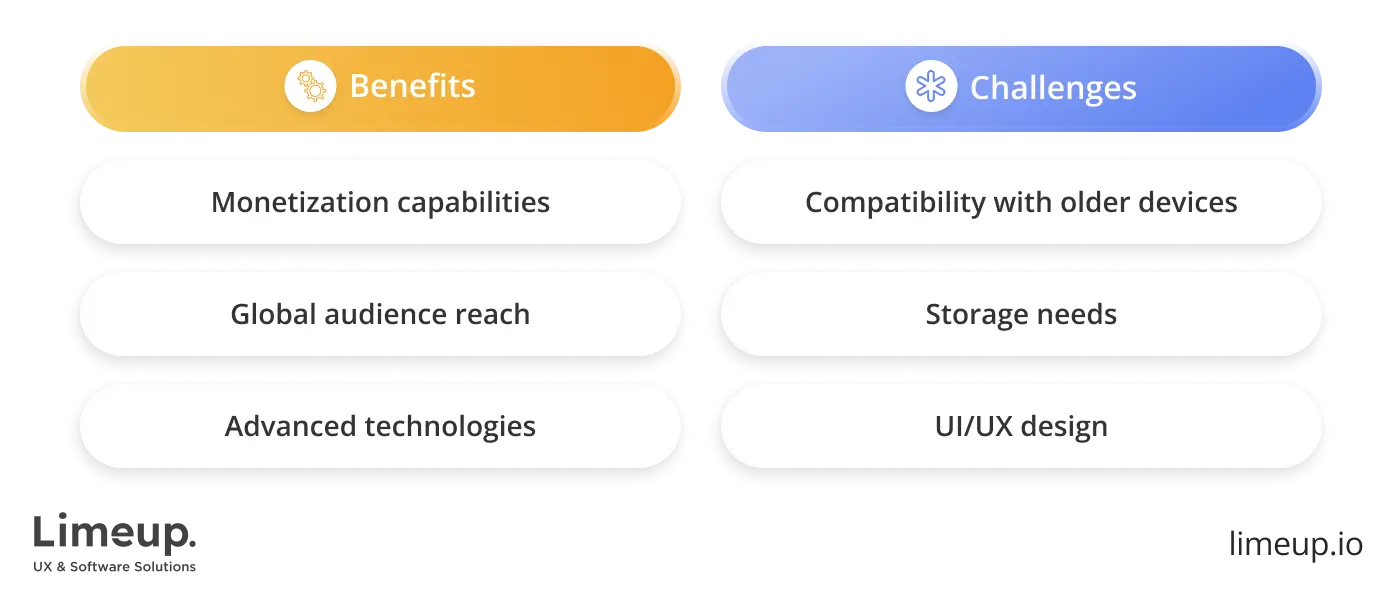
Advantages
No need to say that we are mostly available 24/7 on our smartphones, downloading new apps from AppStore, and it’s a blessing in disguise for app providers who would like to reach out to a wider target audience and increase brand awareness across millions of iPhone users.
Developing iOS apps in terms of their pros is also about gaining more revenue capabilities but why would we tell it shortly? — let’s define the top 5 beneficial moments you are able to meet when creating an application:
Monetization capabilities are widely diverse, and it’s a core advantage for business owners, so let’s define some strategies to be named, like in-app purchase since AppStore allows you to set subscription-based AIPs when users are paying for premium support, features, content and more.
You are also able to receive revenue from ads — banners, rewarded, native and others that are provided by your partners or platform, for example, if you are a game app owner, you are able to add video ads for extra lives and users will be likely to click on it and overview 15-30 seconds of advertisements while you are earning money effortlessly.
Global audience reach also stands for a loyal and affluent user base which is willing to spend more money on apps that are worth their attention. Since Apple has over 1 billion active users and is available in 175+ countries, you are able to provide your application to such a wide range of people who are ready to pay for your solution.
This point also includes not-that-obvious but still essential points such as global payment options and methods, including local ones so that users are able to make the in-app purchases we have considered above effortlessly and with their smartphones without the need to add card details or else.
Advanced technologies implementation in iOS app development allows you to earn a competitive advantage since you are able to build an app considering Augmented Reality (ARKit) for interactive gaming, real-world map navigation, education, and else. Machine Learning and AI are used for personalization, automation of repetitive tasks, better user experience and engagement.
Therefore, no matter what your industry is, like healthcare, education, fintech, you will be able to implement cutting-edge technologies and receive more related benefits. When it comes to security measures, within pre-built Face ID, your customers are able to protect some content and sensitive information, enable secure authentication and more.
Challenges
We have covered the tech stack and benefits but you still have to be updated with challenges that can be faced by even tech-savvy developers. Let’s define 5 hardest moments related to you as a business owner as well:
Compatibility with older devices within iPhone applications development is all about hardware limitations in the first place since older devices have less processing power, memory, weaker graphics performance so you have to optimize your app so that it runs smoothly maybe sacrificing advanced features and reducing performance.
iOS version fragmentation is also a challenge that leads to limitations since you have to support a wide range of versions with compatibility maintenance, which may increase development timeframes and costs. Battery performance isn’t a recent entrant to the market, but an essential point to avoid heat issues and optimize resource usage by older iPhones.
Storage needs may be a challenge since devices have different amounts of storage and you have to balance between performance and user experience. There’s also a possibility of bloated databases so minimizing redundant data is necessary in app performance. Cloud integration is an option when storage is limited but the challenge is in synching information between local and cloud solutions.
Sounds a bit complicated in terms of how to develop iOS app but wait, here is also file management, which stands for handling large files related to media, caching, retrieving files which are crucial for performance.
In terms of security, you may face the need to encrypt sensitive data balancing between protection and efficiency of storage, so we recommend using tools like Keychain.
UI/UX design considered as a part of the development process stems from the need for visually appealing and intuitive solution so that you have to keep the balance between guide, unique brand positioning and features to be developed as well as take into consideration screen sizes for iPhones and iPads.
Something that is not immediately obvious but still essential, a commonly overlooked aspect is dark mode support, which requires additional UI elements and colors.
We have considered core challenges addressing which is a daunting task that can be done effortlessly with a reliable vendor.
Top trends in iOS mobile app development
Learning about cutting-edge trends is essential for businesses that would like to stay ahead of the competition so if you are a new kid on the block in terms of practical app creation, here you will find in-demand 5 trends to consider before contacting a vendor who can deliver this solution:
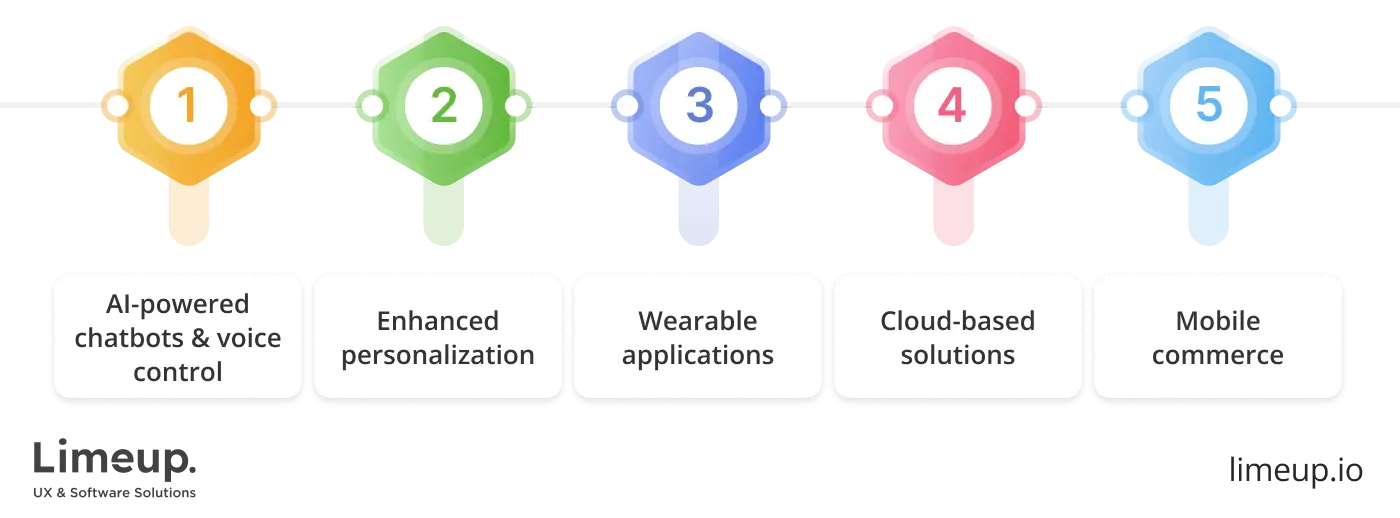
Artificial intelligence-powered chatbots and voice control. Advanced technologies to be used open a variety of opportunities when you decide to develop iOS apps that include NLP, Voice Integration (Siri), customer support and more. Accurate responses from a virtual assistant are a must for a seamless user experience so you have to ensure it operates smoothly with the implementation of AI/ML technologies.
Enhanced personalization. Tailored application may sound like an uphill battle to you, but let’s us provide you with an example — healthcare and fitness-related solutions provide insights, fitness routines, wellness recommendations according to unique data the used enter in app and gathered from other activities.
Apple also highly values privacy so that you are able to personalize without compromising user data.
Wearable applications. To create iOS app for Apple Watch and other smartwatches offers you a variety of capabilities when it comes to revenue since you are able to deliver solutions for fitness tracking, payments, plans for workouts, fintech-related apps and more. Core trends inside include hands-free interactions, specific features like advanced notifications.
Cloud-based solutions. This trend may feel like herding cats but with a reliable provider you are able to receive numerous beneficial moments from Backend-as-a-service with backend infrastructure ready to be implemented to data synchronization and app updates. Cloud vendors also offer built-in security features such as encryption so that your app meets data protection requirements.
Mobile commerce. Online shopping within a smartphone is not a dream anymore, more like a common thing in users’ lives so what’s trendy here? — first, it’s in-app purchases so that customers can pay within Apple Pay and not enter card data, only using Face ID to confirm the payment. Personalization in terms of m-commerce is all about shopping experiences, tailored notifications and recommendations, promotions based on preferences and checkouts.
Overall, you don’t need to implement every trend, it’s OK and more preferable to choose one or two cutting-edge technologies that will benefit your business, and you can achieve it effortlessly with a reliable provider that will provide you with a proper experience in iOS application development making your app engaging and user-friendly.
Summing up
The next step is up to you when it comes to the question “How to develop an app for iPhone?” since we have considered every essential option from basic requirements to core beneficial moments, features, challenges, trends. The writing is on the wall that developing such an app is a daunting task and the sky’s the limit when it comes to functionality.
Considering the development process, we defined how to create an app for you to have no doubts and hardness about tools, planning, adherence to Apple guidelines. In practice, you may face various roadblocks, but with our guide, developing will be like walking in a park since you will have knowledge under your belt.
Typically, there’s also an opportunity to use app builder, which we haven’t considered in this article because it’s a way to create off-the-shelf solutions that are not tailored to custom end-users’ needs so we have focused on out-of-the-box app creation that brings more value and revenue to customers.
We have contemplated every stage in developing iOS apps from app conceptualization to enhancing it within users feedback so you have ensured it’s a comprehensive guide which hopefully was a useful one for you to be encouraged when it comes to app creation.

